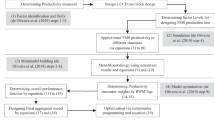Abstract
Owing to various end-uses and good performance/cost ratio, the multifunctional textile materials have been significantly developed within a decade. Such materials are mostly dedicated to niche or limited markets and used for producing high-valued products. Facing the international competition, designers are strongly involved in the development of new advanced materials in order to satisfy complex customer requirements and specifications with a reduced design cycle. In practices, these design requirements are numerous and contradictory, corresponding to a multi-criteria optimization problem. In this paper, we propose an original optimization method for the design of multifunctional textile materials. Using intelligent techniques, this method permits to determine a relevant operation setting space, helping designers to quickly realize a set of representative prototypes. These prototypes can lead to a quick convergence to the predefined quality specifications with a small number of trails and low cost. The effectiveness of proposed method has been illustrated and validated through a case study.
Similar content being viewed by others
References
Sorli M., Stokic D.: Innovating in Product/Process Development, Gaining Pace in New Product Development. Springer, London (2009). doi:10.1007/978-1-84882-545-1_3
Halevi G.: Industrial Competitiveness Cost Reduction. Springer, Netherlands (2008). doi:10.1007/1-4020-4350-3_8
Vroman, P.: Intelligent design and production of advanced nonwoven products: from market needs to industrial processing. In: 5th International Conference on Advanced Fibre/Textile Materials, Udea, Japan (2007)
Deng X., Vroman P., Zeng X., Koehl L.: Determination of relevant process operation setting space for developing multifunctional nonwoven-based products. Text. Res. J. 79, 1378–1388 (2009). doi:10.1177/0040517508097524
Good P.: Experimental Designs, book chapter, Permutation, Parametric and Bootstrap Tests of Hypotheses, 3rd edn, pp. 85–118. Springer, New York (2008). doi:10.1007/b138696
Boer E.P.J., Hendrix E.M.T.: Global optimization problems in optimal design of experiments in regression models. J. Glob. Optim. 18(4), 385–398 (2004). doi:10.1023/A:1026552318150
Emad A.N., Kamrani A.K.: Rapid Prototyping, Book Chapter, Computer-Based Design and Manufacturing, pp. 281–301. Springer, US (2007). doi:10.1007/978-0-387-23324-6_11
Pardalos P.M., Siskos Y., Zopounidis C.: Advances in Multicriteria Analysis. Kluwer, Dordrecht (1995)
Zopounidis C., Pardalos P.M.: Handbook of Multicriteria Analysis, Series: Applied Optimization. Springer, Berlin (2010). doi:10.1007/978-3-540-92828-7
Pardalos P.M.: Linear Programming, in Book Encyclopedia of Optimization, 2nd edn, pp. 1883–1886. Kluwer, Dordrecht (2009). doi:10.1007/978-0-387-74759-0_336
Keeney R.L., Raiffa H: Decisions with Multiple Objectives: Preferences and Value Trade-Offs. Wiley, New York (1976)
Bouyssou D.: Outranking Methods, in Book Encyclopedia of Optimization, 2nd edn, pp. 2887–2893. Kluwer, Dordrecht (2009). doi:10.1007/978-0-387-74759-0_495
Siskos Y.: Preference Disaggregation, in Book Encyclopedia of Optimization, 2nd edn, pp. 3031–3042. Kluwer, Dordrecht (2009). doi:10.1007/978-0-387-74759-0_519
Chinchuluun A., Pardalos P.M.: A survey of recent developments in multiobjective optimization. Ann. Oper. Res. 154(1), 29–50 (2007). doi:10.1007/s10479-007-0186-0
Deng, X., Zeng, X., Vroman, P., Koehl, L.: Selection of relevant variables for industrial process modelling by combining experimental data sensitivity and human knowledge, Eng. Appl. Artif. Intel. (in press)
Cameron L.T., Ingram G.D.: A survey of industrial process modelling across the product and process lifecycle. Comput. Chem. Eng. 32(3), 420–438 (2008). doi:10.1016/j.compchemeng.2007.02.015
Medvedev V., Dzemyda G.: Optimization of the local search in the training for SAMANN neural network. J. Glob. Optim. 35(4), 607–623 (2006). doi:10.1007/s10898-005-5368-1
Hernández E., Recasens J.: A General Framework for Induction of Decision Trees Under Uncertainty, Book Chapter, Modelling with Words Learning, Fusion, and Reasoning within a Formal Linguistic Representation Framework. Springer, Berlin (2003). doi:10.1007/b94063
Marinakis Y., Marinaki M., Doumpos M., Matsatsinis N., Zopounidis C.: Optimization of nearest neighbour classifiers via metaheuristic algorithms for credit risk assessment. J. Glob. Optim. 42(2), 279–293 (2007). doi:10.1007/s10898-007-9242-1
Lu J., Zhang G.Q., Ruan D.: Fuzzy multi-objective decision-making models and approaches. Fuzzy Multi Criteria Decis. Mak. (Springer Optim. Appl.) 16(2), 483–522 (2008). doi:10.1007/978-0-387-76813-7_19
Sherali H.D., Desai J.: A global optimization RLT-based approach for solving the fuzzy clustering problem. J. Glob. Optim. 33(4), 597–615 (2005). doi:10.1007/s10898-004-7390-0
An L.T.H., Belghiti M.T., Tao P.D.: A new efficient algorithm based on DC programming and DCA for clustering. J. Glob. Optim. 4(37), 593–608 (2007). doi:10.1007/s10898-006-9066-4
Pena J.M., Lozano J.A., Larranaga P., Inza I.: Dimensionality reduction in unsupervised learning of conditional gaussian networks. IEEE Trans. Pattern Anal. Mach. Intel. 23(6), 590–603 (2001). doi:10.1109/34.927460
Zeng X., Liu Z.: A learning automata based algorithm for optimization of continuous complex functions. Inf. Sci. 174(3), 165–175 (2005). doi:10.1016/j.ins.2004.09.004
Drnovsek R., Peperko A.: Inequalities for the Hadamard weighted geometric mean of Positive kernel operators on Banach function spaces. Positivity 4(10), 613–625 (2006). doi:10.1007/s11117-006-0048-z
Abe S., Lan M.: Fuzzy rules extraction directly from numerical data for function approximation. IEEE Trans. SMC. 25(1), 119–129 (1995). doi:10.1109/21.362960
Lin C.T., Lee C.S.G.: Neural network-based fuzzy logic control and decision system. IEEE Trans. Comput. 40(12), 1320–1336 (1991). doi:10.1109/12.106218
Andrzej O., Stanislaw K.: Evolutionary algorithms for global optimization. Nonconvex Optim. Appl. 85, 267–300 (2006). doi:10.1007/0-387-30927-6_12
Sivanandam, S.N., Deepa, S.N.: Genetic Algorithm Implementation Using Matlab, Book Chapter, Introduction to Genetic Algorithms, pp. 211–262 (2008). doi:10.1007/978-3-540-73190-0_8
Gerardo B.D., Lee J.W., Malrey Y.S., Malrey L.: The K-means clustering architecture in the multi-stage data mining process, book chapter. Comput. Sci. Appl. 3481, 71–81 (2005). doi:10.1007/11424826_8
Author information
Authors and Affiliations
Corresponding author
Rights and permissions
About this article
Cite this article
Deng, X., Zeng, X., Vroman, P. et al. An intelligent multi-criteria optimization method for quick and market-oriented textile material design. J Glob Optim 51, 227–244 (2011). https://doi.org/10.1007/s10898-010-9606-9
Received:
Accepted:
Published:
Issue Date:
DOI: https://doi.org/10.1007/s10898-010-9606-9




